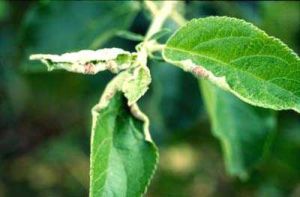Apple Leaf Curling Midge
General Description
Apple leaf midge is an introduced pest from Europe first observed in Okanagan Valley in 2003 but present in Fraser Valley since early 1990s.
Hosts
Apple
Damage
Larval feeding causes leaves to curl tightly upwards and the tissue to thicken, often displaying a purplish color (Figs. 1, 2). Damage is easily confused with aphid infestations. Feeding on terminal leaves reduces terminal growth and may distort limb growth; leaves may drop prematurely. There is no evidence of reduced fruit quality or quantity in bearing trees. Primary impact is to delay or stunt structural development of nursery and young bearing trees.
 |
|
| Figure 1. Apple leaf midge damage. (H Philip) | Figure 2. Apple leaf midge damage. (H. Philip) |
Identification
Larva - White to orange-red (depending on age), legless, maggots up to 3 mm long (Fig. 3).
| Figure 3. Mature apple leaf midge larvae. (H. Philip) |
Adult female - Delicate mosquito-like fly, dark brown body with reddish abdomen, about 2-3 mm long.
Adult male - Male resembles female but lacks reddish abdomen.
Life History
There are three generations per year in Interior British Columbia and adults are present from April - September. Apple leaf midge overwinter as pre-pupae or pupae in the soil and occasionally in curled leaves or other protected sites beneath host trees. Adults begin to emerge in May to mate and lay eggs on the edge of terminal apple leaves. Larvae feed inside the leaf galls for 2-4 weeks. Pupation occurs in late May to early June with second-generation larvae appearing in June and July and a third in July through September (Dr. Joan Cossentine, Summerland Research and Development Centre).
Monitoring
Inspect developing shoots of nursery and young trees less than 2-3 years old for curled, often purplish, curled terminal leaves containing white to bright orange maggots. In the UK, researchers have identified female sex pheromones for trapping males. A threshold of 30 adults/trap/week is used for timing insecticide sprays.
Management
Biological Control
Pirate bugs actively feed on larvae and Campylomma have also been observed within infested leaves. A parasitoid wasp, Synopeas myles attacks apple leaf-curling midge larvae in British Columbia. Parasitism rates of up to 30% have been recorded in Okanagan-Similkameen apple orchards (Dr. Joan Cossentine, Agriculture and Agri-Food Canada, Summerland).
Cultural Control
There are no cultural methods that will adequately reduce the risk or severity of apple leaf midge infestations. Hand removal and destruction of infested leaves may help but removing terminal leaves can result in the same impact on tree development. Proper management of susceptible trees will help minimize the impact of the midge.
Chemical Control
Delegate (spinetoram), Movento (spirotetramat), Ripcord (cypermethrin), Up-Cyde (cypermethrin), and Decis (deltamethrin) are registered for control of apple leaf midge. Ripcord (cypermethrin), Up-Cyde (cypermethrin), and Decis (deltamethrin) are not effective against larvae in leaf curls, are harmful to beneficial insects and mites, and would lead to mite flare ups. Field trials in Ontario indicated Movento provides good control of the midge at petal fall timing.
See pesticide usage (top left menu) for additional information on products.
